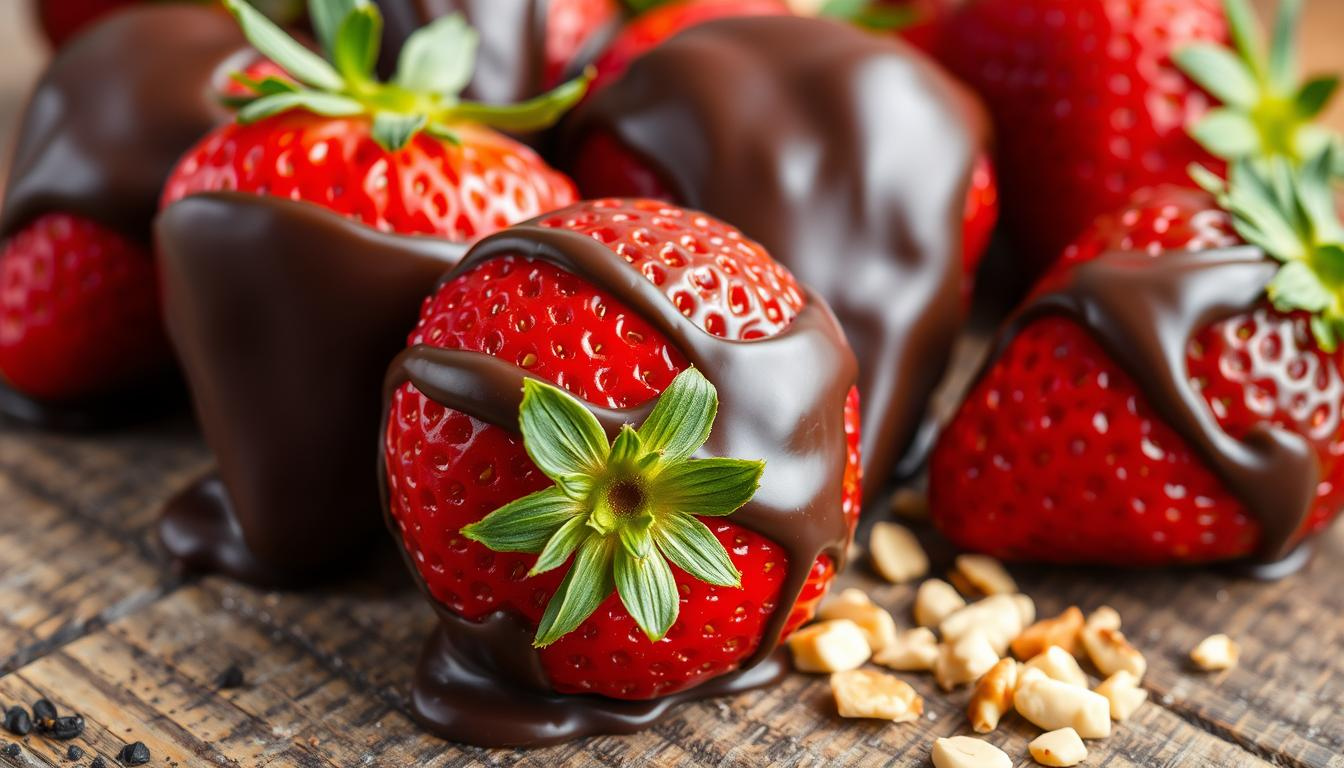If you’re searching for a dessert that’s as indulgent as it is healthy, this carob covered strawberries recipe is your perfect match. Combining the natural sweetness of carob with the juicy freshness of strawberries, this treat is a guilt-free alternative to traditional chocolate-covered strawberries. Whether you’re looking for a vegan, dairy-free, or caffeine-free dessert option, these carob-coated delights tick all the boxes. Ideal for special occasions or everyday snacking, this easy recipe brings flavor, nutrition, and elegance to your table. Ready to dive in? Let’s get started!

Key Takeaways
- Carob is a healthy alternative to chocolate, offering natural sweetness and caffeine-free properties.
- This carob covered strawberries recipe is easy to make at home with just a few simple ingredients.
- Enjoy a delicious and vegan-friendly treat that’s perfect for any occasion.
- Carob provides various nutritional benefits compared to traditional chocolate.
- Discover the essential tools and techniques for perfectly melting and dipping the carob.
Why Choose Carob Over Chocolate?
Carob is nature’s answer to chocolate—with some key differences. Unlike chocolate, carob is naturally sweet, contains no caffeine, and is loaded with fiber and antioxidants. It’s a perfect alternative for those avoiding caffeine, dairy, or processed sugars. Learn more about the health benefits of carob in this comprehensive guide.
But what about the strawberries? They’re not just pretty—they’re nutritional powerhouses, bursting with vitamins, antioxidants, and fiber. Discover all the health benefits of strawberries here.
Nutritional Benefits of Carob vs Chocolate
Carob is a nutritional powerhouse, full of vitamins and minerals. It’s caffeine-free and has less fat than chocolate, making it a better option for a carob coating or healthy indulgence. Plus, it’s sweeter than chocolate, so you don’t need as much sugar.
Carob also has lots of antioxidants that help fight off harmful free radicals. This makes it perfect for adding more antioxidant-rich sweets to your diet.
Natural Sweetness and Caffeine-Free Properties
Carob’s natural sweetness is a big plus. It gets its sweetness from a natural sugar called sucrose, giving it a great taste without needing lots of added sugar. This makes carob a great pick for those who want a healthy indulgence without the caffeine in chocolate.
Choosing carob over chocolate lets you enjoy a carob coating on your favorite treats, like these yummy carob-covered strawberries. You’ll get all the nutritional benefits of this versatile ingredient.
Essential Ingredients for Carob Covered Strawberries Recipe
Making carob covered strawberries recipe at home is simple. The secret is knowing the right ingredients. Let’s take a look at what you need to make your strawberry dessert extra special with a rich carob topping.
Fresh strawberries are the base for this recipe. Choose the ripest and juiciest ones for the best taste and texture. For the carob topping, use premium carob flakes. Carob tastes like chocolate but doesn’t have the caffeine.
To make your carob covered strawberries even creamier, try adding coconut oil or nut butter. These additives help thin the carob for easier dipping and add richness.
If you’re on a special diet, this recipe can be easily modified. Use vegan carob flakes and choose your favorite nut or seed butter for a delicious vegan dessert.

“With a naturally sweet taste that goes well with fresh strawberries, carob is a tasty and healthful substitute for chocolate.”
Explore more decadent dessert ideas on our homepage.
Key Ingredients for Carob Covered Strawberries
- Fresh, ripe strawberries
- High-quality carob chips
- Coconut oil or nut butter (optional)
With these basic, healthy ingredients, you’re ready to make a beautiful carob covered strawberries recipe. Your sweet craving will be satiated and your taste buds will be impressed.
Required Kitchen Tools and Equipment
Making tasty easy fruit recipe like carob covered strawberries at home is simple. Just a few simple kitchen tools are required. Let’s examine what you’ll require to get started.
Temperature Control Tips for Carob Melting
When you melt carob chips for your strawberries, keeping the temperature right is crucial. The best range for carob is 95-105°F. If it gets too hot, the carob can burn or become grainy.
Use a double boiler or the microwave in short bursts to melt the carob. Stir it often to keep it smooth.
Storage Container Recommendations
- Airtight containers with lids, like glass jars or plastic ones, are great for storing your treats.
- Put parchment paper or silicone mats in the containers to stop the treats from sticking.
- Keep the treats in a cool, dry place, away from sunlight or heat, to keep them fresh.
With the right tools and a bit of temperature control, you can make delicious easy fruit recipe and no-bake snacks. They’ll make your taste buds happy and satisfy your sweet tooth.
Selecting and Preparing Fresh Strawberries
Making delicious strawberry desserts like carob-covered strawberries starts with the best strawberries. The quality of the strawberries you use is key to enjoying a great, healthy meal. Let’s explore how to choose and prepare the perfect strawberries for your carob-covered strawberries recipe
Selecting the Freshest Strawberries
For delicious carob-covered strawberries, start with high-quality strawberries. Look for strawberries that are plump, firm, and bright red with fresh green tops. Stay away from strawberries that are shriveled, broken, or have white or green spots. They may not taste or feel good for your carob-covered strawberry recipe.
Washing and Drying Strawberries
Once you’ve chosen the perfect strawberry dessert for , it’s time to prepare them for carob. Gently wash the strawberries under cold water, but don’t soak them. This will keep them from becoming wet. Next, use paper towels or a fresh towel to pat them dry. Make sure they’re dry before dipping them in the carob. By choosing the freshest strawberries and preparing them properly, you’re on your way to a delicious, healthy treat. Your homemade carob covered strawberries recipe will be a hit.
Step-by-Step Guide to Making Carob Covered Strawberries
Discover how to melt carob chips to bring out their delicious flavor. This guide is for both experienced chefs and home cooks. It shows you two easy ways to melt carob chips for your carob coating or chocolate substitute projects.
Double Boiler Method
The double boiler method is a trusted way to melt carob chips. Here’s how to do it:
- Put a few inches of water in a pot and turn the heat up to medium.
- Put a heatproof bowl on top of the saucepan, making sure it doesn’t touch the water.
- Add your carob chips to the bowl and stir them until they melt into a smooth, creamy mix.
- Stay patient and don’t raise the heat too high. This can make the carob seize or burn.
Microwave Melting Instructions
For a faster way, you can melt carob chips in the microwave. Just follow these steps:
- Put the carob chips in a microwave-safe bowl.
- Heat the chips in 30-second bursts, stirring between each interval, until they melt smoothly.
- Watch the chips closely to avoid burning or overheating, which can ruin the texture.
Choose the method you like best. Stir the melted carob often to keep it smooth for your carob coating or chocolate substitute projects.
With these easy steps, you’re ready to make tasty carob coating treats at home. Enjoy using this healthy option and let your creativity in the kitchen shine!
Perfect Carob Dipping Techniques
Learning to dip strawberries in melted carob is key for a tasty and pretty treat. A few simple steps can help you get even coverage and avoid drips. This way, you’ll get the perfect carob coating every time.
Keeping the melted carob at a steady temperature is very important. Aim for 100-110°F for the best dipping consistency. If it gets too thick, add a bit of coconut or vegetable oil to thin it out.
- Gently hold the strawberry by the stem and dip it into the melted carob, rotating it slowly for even coverage.
- Take the strawberry out of the carob, letting any extra drip back into the bowl. This prevents a messy coating.
- To set, place the dipped strawberry on a cooling rack or baking sheet lined with parchment. Do this for all the strawberries.
For a smoother finish, try the “double dip” method. Dip the strawberry in carob, let it set for a minute, then dip again for a thicker coat.
“Dipping the strawberries in melted carob is a fun and easy way to create a healthy, delicious treat at home.”
Remember, the secret to great easy fruit recipes is to work fast and gently. With a bit of practice, you’ll be a pro at dipping in carob!
Creative Toppings and Decorative Elements
Add a creative touch to your carob covered strawberries. Try different toppings and decorations. They not only look great but also add extra health benefits to your vegan dessert.
Nuts and Seeds Options
Top your strawberries with chopped nuts and seeds for a crunchy texture. Choose from almonds, walnuts, pecans, pumpkin seeds, or sunflower seeds. Each adds a unique flavor and texture that pairs well with the carob.
Superfood Garnishes
Make your antioxidant-rich sweets even better with superfood garnishes. Use goji berries, chia seeds, shredded coconut, or melted cacao nibs. These superfoods bring color and extra nutrients to your vegan dessert.
Be creative with your toppings to make your strawberries stand out. The mix of nuts, seeds, and superfoods will impress your guests and make your dessert unforgettable.
Storage Tips for Carob Covered Strawberries
Enjoying your strawberry treats with carob coating is just the start. Keeping them fresh is crucial. Here are some easy tips to keep your no-bake snacks fresh for longer.
First, keep them in the refrigerator in an airtight container. This keeps moisture in and prevents the carob from melting. Don’t leave them out for too long, as the carob can soften and strawberries can get too ripe.
For the best taste, eat your carob covered strawberries within 3-5 days. The carob and strawberries have a short shelf life. If you see mold or a bad smell, throw them away.
To make them last longer, freeze them. Put the coated strawberries on a parchment-lined baking sheet and freeze until hard. After that, place them in a freezer bag or an airtight container. You can keep frozen strawberries for up to two months.
Proper storage is key to enjoying your no-bake snacks. Follow these tips to keep your carob covered strawberries fresh and tasty. This way, you can enjoy them whenever you want.
Troubleshooting Common Carob Coating Issues
Making perfect carob-coated strawberries at home is fun, but you might face some problems. Don’t worry! We have some tips to help you fix common carob coating issues.
Fixing Thick or Thin Consistency
Getting the right consistency for your carob coating is key for smooth, even coverage. If it’s too thick, add a bit of coconut oil or plant-based milk. Stir gently until it’s just right. If it’s too thin, melt in a few more carob chips to thicken it.
Preventing Bloom Formation
Carob bloom, a whitish discoloration, can be a problem. To avoid it, temper your carob by heating it right and cooling it slowly before dipping. Also, keep the coated strawberries in a cool, dry place to prevent bloom.
By tackling these common carob coating issues, you’ll make beautifully coated strawberries. They’ll look great and taste amazing with their carob coating and chocolate substitute flavors.
“Mastering the art of carob-coated strawberries is a delicious journey worth taking!”
Serving Suggestions and Presentation Ideas
Your delicious carob covered strawberries can be enjoyed in many ways. For a simple yet elegant look, arrange the berries on a platter or serving tray. Add a few sprigs of fresh mint or a dusting of cocoa powder to enhance their beauty. This makes a stunning centerpiece for any event, from casual gatherings to formal dinners.
Looking to add your carob covered strawberries to a dessert spread? Serve them with other treats like chocolate-dipped pretzels or artisanal cheeses. The sweet and tangy carob pairs well with fresh strawberries, offering a delightful contrast. You can also skewer the berries for a fun finger food.
For a healthier option, pair your carob covered strawberries with a fruit salad or yogurt parfait. The carob’s natural sweetness and health benefits make it perfect for desserts and snacks. This way, you can satisfy your sweet tooth while keeping your diet balanced. With their versatility and attractive look, your carob covered strawberries will be the highlight of any menu or gathering,explore more decadent dessert ideas on our homepage.
FAQ
What are the benefits of choosing carob as a chocolate substitute?
Carob is a healthier choice than chocolate. It’s naturally caffeine-free and has less fat and sugar. It’s also packed with antioxidants and fiber. Plus, its natural sweetness makes it perfect for treats like carob covered strawberries.
What ingredients do I need to make carob covered strawberries?
You’ll need carob chips, fresh strawberries, and optional add-ins like nuts or coconut flakes. You’ll also need a double boiler or microwave for melting the carob. A baking sheet or parchment paper is needed for setting the coated strawberries.
How do I properly melt the carob chips for coating the strawberries?
To melt the carob chips, use a double boiler or the microwave. For the double boiler, simmer water in a saucepan and place a bowl with the carob chips over it. Stir until smooth. Or, melt in the microwave, stirring every 30 seconds until smooth.
What’s the best way to dip the strawberries in the melted carob?
Hold the strawberry by the stem and dip it into the melted carob. Rotate it to coat evenly. Lift it out, letting excess drip back into the bowl. Place it on parchment-lined baking sheet to set.
Can I add toppings or decorations to the carob covered strawberries?
Yes! You can add toppings like chopped nuts, shredded coconut, or cacao nibs. A drizzle of melted white carob is also great. Get creative and enjoy different textures and flavors.
How should I store the carob covered strawberries?
Store them in the fridge in an airtight container. They last 3-5 days. Don’t leave them at room temperature for too long, as the carob can soften or melt.
What should I do if the carob coating is too thick or thin?
If it’s too thick, add a bit of coconut oil or vegetable oil. Stir until right. If it’s too thin, heat it a bit more in the double boiler or microwave. Stir often until it thickens.

